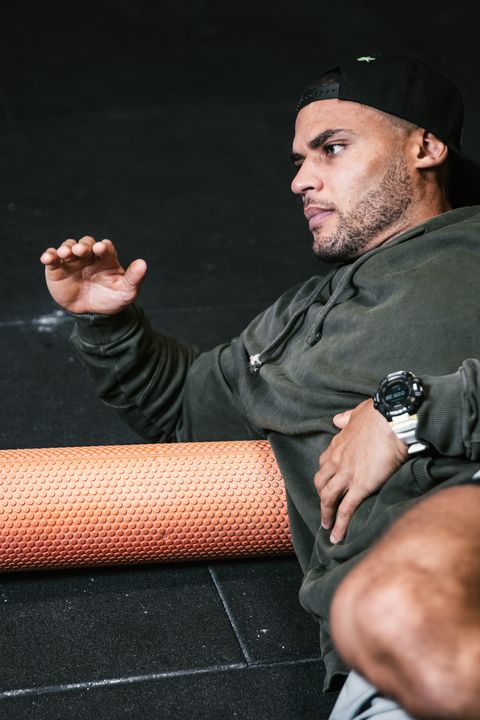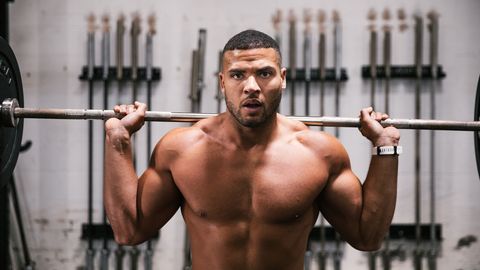British CrossFit athlete Zack George has had a complicated career. After eight years in the sport, the 32-year-old Brit became the fittest man in the United Kingdom in 2020 by winning the CrossFit Open. That qualified him for the CrossFit Games, but then he lost the spot due to the pandemic. The following year, his season was cut short by a flare-up of IT band syndrome, which was so painful he couldn’t squat more than 150 pounds.
This year, George put up strong numbers during the first stages of the CrossFit Games qualifiers. However, he faltered in the Semifinals and won’t be competing at the Games, at least not this year.
George took some time to talk to MH about training through injuries, the 80/20 rule, and the ways to be successful as one of the heaviest guys in the field.
First off, how’s your body feeling? Are you still feeling the injury from 2021?
I always struggle with my ankles and feet. I’m flat-footed so my ankles rolled in, which puts pressure on my knees. I’ve dealt with it all my career and even saw a specialist who recommended surgery to get the foot in the right position. But that would mean I’d be out a year, a year and a half, and I could never really afford to take that much time out. So I’ve just been trying to deal with the issues as best as I can. It’s just a part of what I do, and I’m very knowledgeable about what I can and can’t do.
Did you always know you had this vulnerability?
It’s actually what stopped me from playing rugby. I used to play rugby for my county, and from the age of 14 to 17, my ambition and what I thought I was going to do was become a professional rugby player. That’s the path that I was on.
And then around the age of 17, every game I’d roll my ankle two to three times. If I did a sharp turn, I’d get a sharp pain down my knee, and it wasn’t until six months into the season of repetitively doing this over and over again that someone said, “It’s because you’re flat-footed.”
What was different about 2021? If you’d dealt with this issue for so long, how come it escalated to become such a problem that year?
I think it’s partly missing out in 2020, which made me really want to make a big statement in 2021. So I could feel a little niggling in my hip, but because you’re so determined, you try and block it out and pretend everything’s okay. And at the early stages, it wasn’t enough to stop training.
But then, during the Open, I was doing a max lift and felt a shooting pain down into my knee, and I couldn’t squat for about three months.
If I had been smart, I would’ve acknowledged the pain and pulled away from the training a bit. But it took me seven years to qualify for the Games, and to miss out because of Covid, you’re just so determined to make it next year.
Especially at your level, you’re probably never going to feel 100 percent. So what’s the lesson here about when to throttle back?
I knew it was a pain, and I knew it wasn’t just tightness that would work out on its own or my muscles were just feeling sore that day. I knew it was an actual pain going down to my hip, and I think that’s just something that comes from training in CrossFit for so long. You learn to distinguish between what feeling like death during a workout is and something that’s actual pain.
Say you’ve got your left knee that’s hurting you but you’re still training. Your body is going to naturally shift its weight to the right side, and then you normally get a sort of niggling in your right knee, too. And then it’s one thing after another. So, you have to be really careful about not letting things get out of hand. At least for me, I spent a lot more time on recovery now.
What does that look like?
I’m seeing a physio at least twice a week. I make sure I get enough sleep. I stretch an hour every day and make sure that I use all of my recovery tools, including my ice bath. I get in it once every four days to waist height for three minutes. Then I’ll go in fully submerged every two weeks.
What do you recommend for nutrition for other people?
I always tell people to live an 80/20 split. So your goal is to stay in shape and live a healthy lifestyle, but you’re not an athlete, so you don’t have to be 100 percent on point every single day and every single month. Eat healthy Monday through Friday. On the weekends, go out with friends, have drinks, eat dessert. Life’s about balance. If you eat well 80 percent of the week, then 20 percent of the week enjoy yourself.
What’s your favorite protein source?
Clear Whey by MYPROTEIN. I don’t really like thick, milky protein shakes. This one tastes like fruit juice, and it’s an absolute game changer. It has vitamin D, Omega-3s, creatine, and beta alanine, too.
At 220 pounds, you’re one of the biggest elite CrossFitters by a lot, probably 30 pounds [George is typically listed at 6′, 100kg]. How has that affected your training and how you approach the sport?
I spend a lot of time on gymnastics and fitness because strength has never really been an issue for me. The first time I ever touched a barbell, I cleaned 240 pounds. I’ve always been a strong rugby player. I know I can not touch a barbell for a month and then power clean 350. But then, if I don’t do ring muscle-ups for a month, I’ll lose 50 percent of my capacity.
So very early on, I knew what kind of athlete I was and what I needed to work on. It took me a long time to do a ring muscle-up or a bar muscle-up or handstand walks or anything bodyweight related. If you’re a bigger guy—anything over six feet or 200 pounds—that’s probably going to be the case for you, too.
What’s the biggest mistake that you see beginners make when they first start CrossFit?
People running into exercises too soon. Every week we get somebody new and the first thing they want to do is a ring muscle-up. And you say, “Okay, that’s a really complex movement with a lot of strength involved. Can you do five strict pullups? No.” The strength’s not there. The technique’s definitely not there. And if something goes wrong, you can seriously injure yourself. So that’s the big thing, not trying to rush into these complex movements.
At our gym, we have a method we take people through. Even after someone can do five perfect, strict pullups, we take a resistance band and loop it through the rings so they can practice banded transition work. That band helps you turn over and practice the next part of the movement. If you can do that with a black band, which is our least resistance, then we know you’ve definitely got the technique. That’s when we’ll allow you to try the ring muscle-up.
What’s your favorite exercise?
A muscle-up, partly because I enjoy doing it, and I enjoy people’s reaction because they don’t expect that from a big guy.
Least favorite?
Pistol squats because they’re what really mash up my ankles. I can barely squat with my heels on the floor. The mobility in my ankles is that bad. Insoles definitely help, but pistols are what caused my hip issues. It’s 220 pounds going onto one leg that’s already in a bad position with my foot turned in.
Any particular movement you’d recommend for mobility?
A front or back barbell Sots press. You get into the bottom of the squat and put your hands in the snatch position. Staying in the squat, you press the barbell above your head. You can also do it from the front rack in the same position that you’d catch your clean. It’s a really great way to improve your ankle mobility, your hip mobility, and your shoulder mobility. If someone knows how to do it well, it looks easy, but it’s not.
What’s the workout gear you can’t live without?
One hundred percent the Hyperice by Hypervolt, which is a really powerful massage gun. It’s super silent, and I use it twice a day. I also use the Normatec leg sleeves, which has been really good for my hips. It compresses and decompresses the muscles to stimulate blood flow. I use those two tools every day.
What’s the biggest misconception about the way you eat or train?
A lot of people think I’m going to be some big, angry dude. I think it’s from social media and my size, but when they meet me, I’m a really high-pitched, friendly guy. They also say that I’m bigger in real life than I look on Instagram.
This content is imported from OpenWeb. You may be able to find the same content in another format, or you may be able to find more information, at their web site.





Comments are closed.